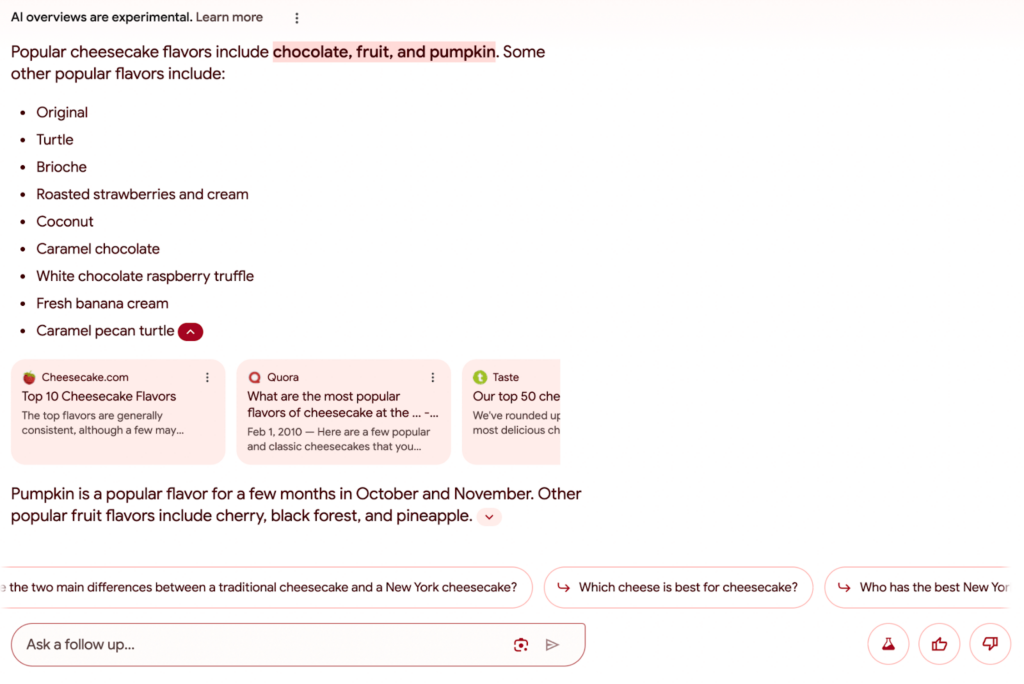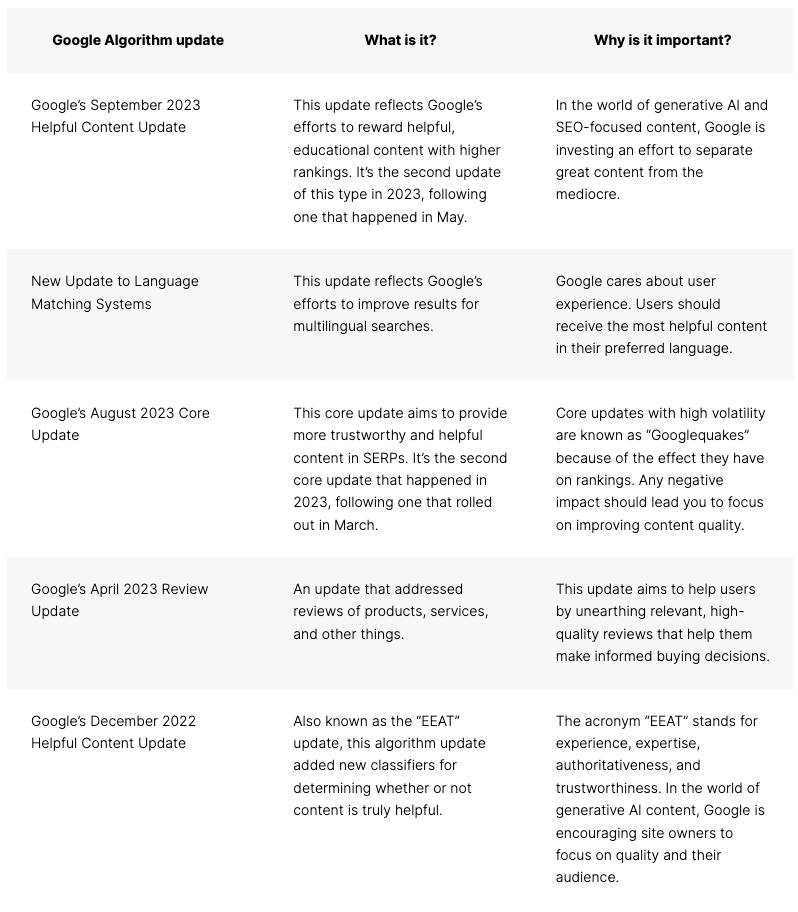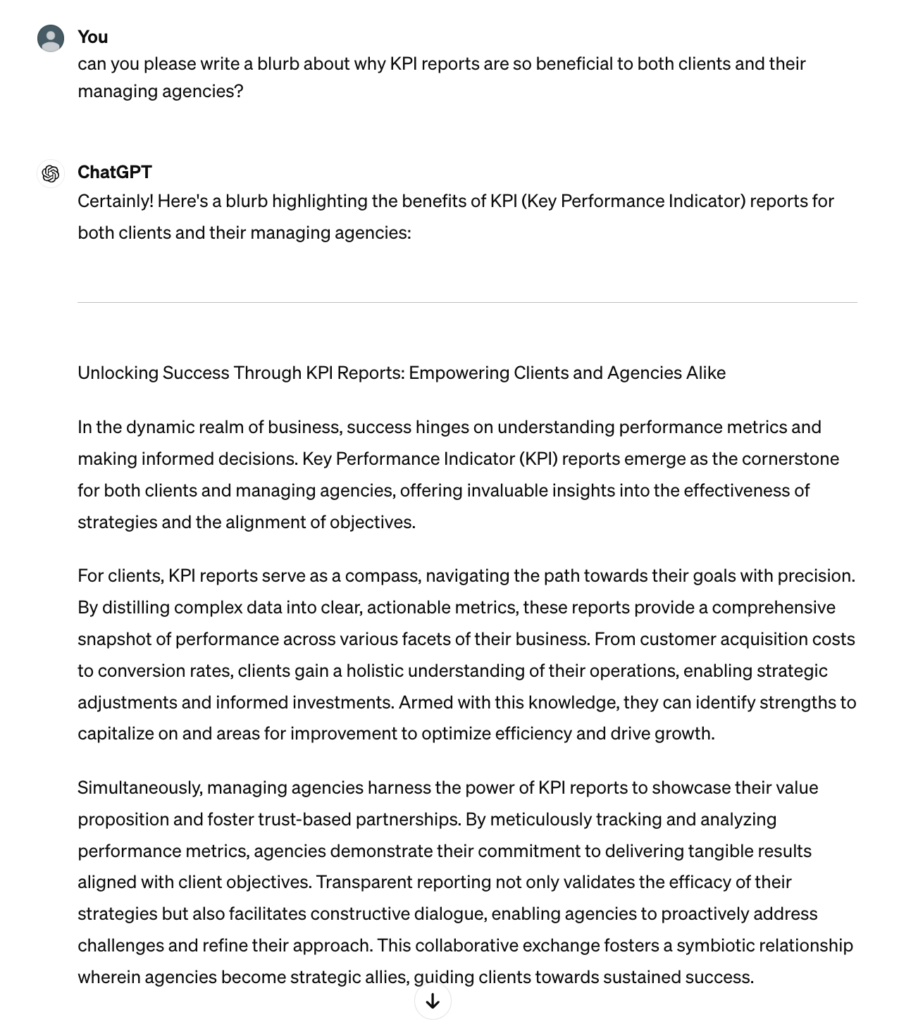And Strategies to Help Keep Your SEO Performance Humming Along
We’re five months into 2024 and many of the biggest challenges in SEO we were keeping an eye on leading up to the new year are now front-and-center – and a big part of our conversations with clients about their SEO strategies.
We used to be able to craft an SEO strategy around a few simple indicators: what your competitors are ranking for, what you want to rank for, and what people are searching for. However, it’s not that cut-and-dried anymore, especially as Google continues to change its search algorithm and AI plays a larger role in content and search.
There are 5 primary challenges in SEO we’re now very mindful of when mapping out our clients’ SEO strategies, and while this list will change and evolve throughout the rest of the year and beyond, these are currently the most significant hurdles to search success.
5 SEO Challenges That Should Influence Your 2024 Strategy
1. Google’s Search Generative Experience (SGE)
SGE is an AI tool you can launch in Google that puts the most detailed information right at the top of your search results page. It’s highlighted so you know you’re looking at the AI-generated stuff, but its placement on the page and the depth of results mean your content gets pushed below it.
Here’s what it looks like when we Googled “popular cheesecake flavors” (don’t ask – we just love cheesecake):

Organic search results aren’t even visible without scrolling down – and SGE provides several avenues for the searcher to continue learning about cheesecake flavors without having to do so.
It should be noted that SGE doesn’t populate for every single query. There are quite a few topics that the AI tool simply isn’t smart enough to handle – yet (sorry SGE).
For example, a Google search for “2024 challenges to SEO” yields these results:

SGE very kindly lets us know there is no AI overview available for the search, so the results with the best optimizations appear at the top – SEMrush (a Fishnet partner) and LinkedIn, because obviously.
However, SGE is still in the beta stage so this information gap won’t last long.
By now you must be wondering how your content is going to compete with a SERP-domineering AI tool, and how you can possibly know which queries will generate an SGE result and which ones won’t (currently). Both are great questions.
Before writing your content, do a Google search with SGE enabled. Not only will you see if the tool pulls up results, but you’ll see who else is ranking and what their content looks like.
This cursory search, coupled with your SEO strategy, will give you a leg up over SGE in the short term. In the long term, you need to optimize your content to be featured by SGE, if that’s important to your business.
Otherwise, your content will still appear on the SERP, but users will have to scroll past the SGE to find it. Not all users will defer to the AI results, so if your content speaks to your audience’s needs and your brand is a known source of information for your audience, you can still win those eyeballs.
To become featured in SGE results, here are a few SEO strategies you’ll want to prioritize:
- Using search keywords and phrases your audience is using, and assigning them to content that maps to where they are on the buyer journey
- Ensuring all content has a focus keyword, meta title, and meta description, as well as alt tags
- Optimizing your content for the focus keywords to ensure it’ll show up in search results
2. Google Algorithm Changes
They say that the only constant in life is change. Well, Google certainly proves that to be true with their continuous (and often rigorous) algorithm updates. We know all too well how stressful these changes can be, especially as they almost always lead to SERP volatility. But by closely monitoring these changes and being prepared to adapt as they roll out, they don’t have to have a big negative effect on your SEO strategy.
Something to keep in mind is that Google’s algorithm changes aim to increase the relevance and helpfulness of search results. The search engine giant prioritizes quality over all else and, in the end, continuously provides millions of searchers with more relevant content with each update. We wrote about this last year when the September 2023 Google Helpful Content Update rolled out:
“While the system is always evolving and updating, Google’s Helpful Content System’s main purpose is to live up to its name; the system uses an evolving algorithm to rank genuinely helpful, well-written content higher and jumbled, poorly-written, generally unhelpful content lower. The goal of this approach is to more efficiently guide users to the answers they’re looking for.”
As we move through 2024, keeping a pulse on all the recent changes can help you reformulate your content and SEO strategies to please the Google algorithm and ensure your content still ranks well in the SERP.
Semrush made a helpful table explaining the five most recent and relevant algorithm updates so that you can stay on track:

Semrush’s main recommendation for avoiding SERP volatility is to stick to the latest SEO best practices. Semrush released their updated SEO best practices in April, which is a fantastic guide for anyone hoping to avoid a big impact on their website traffic. Beyond the best practices, staying on top of algorithm updates and search engine news outlets will ensure your continued SEO success.
3. AI Content Tools
AI content tools are here to stay, setting up shop in the SOPs of millions of marketers and content writers across the world. While there has been an equal amount of excitement and trepidation surrounding the surge of AI use in content creation, and while you might lean more toward the latter end of that spectrum, it’s officially time to accept that it’s here to stay and start with working with it rather than against it. Doing so is especially advantageous as it relates to your SEO success.
In its true double-edged sword fashion, AI-assisted and generated content can be your enemy and your ally in the battle for page one of the SERP. It’s complicated, though, so let’s lay it all out:
First, it’s your ally because it can help you increase the production of high-quality content, improving your chances of ranking well and pleasing the Google algorithm gods.
On the other hand, it’s easy to slip into an AI-generated trance once you give it a try; the ease with which various AI tools, namely ChatGPT, generate topical, seemingly informed content is almost intoxicating. Look at this:

All I asked for was a blurb, but ChatGPT churned out a four-paragraph, in-depth explanation of KPI reports. But content-centric AI is not infallible and ChatGPT is no exception. While everything ChatGPT provided above reads accurate and helpful, it can misunderstand your question or pull inaccurate or outdated information. It’s important to remember that ChatGPT is only as good as the information it’s being given, and it’s up to you, the human with a real human brain, to influence and validate it.
It’s easy to fall into the “quantity over quality” trap which, weirdly, can sort of work at the beginning of a content effort to boost SEO. But when relevance, helpfulness, and accuracy are eclipsed by volume, the algorithm starts to notice and will rank your content lower.
By focusing your AI use on improving the quality of your content, you’ll naturally speed up your processes without sacrificing your unique brand voice and point of view. The trouble is that your competitors are likely doing the same thing.
Focusing on competitive analyses and keyword/content gaps can really give you a leg up in this area. Use Semrush tools like Keyword Gap, Organic Research, and Organic Traffic Insights to look into competitor rankings for their new content. Then, leverage that information and the SEO Content Template tool to bolster your content creation and SEO efforts to creep up on or even beat their rankings.
4. Social Media Content
Staying on top of SEO best practices, algorithm updates, and AI trends is all fun and games until you realize that people are also using social media to search for information. Don’t be alarmed (or roll your eyes) just yet, though! As of 2023, 88% of HubSpot survey respondents said they use search engines for their queries, 31% said they use social media, and 12% said they use AI like ChatGPT.
However, while the majority of people report that they still rely on search engines, 31% using social media for search sometimes or often isn’t a small number.
So, what does this mean for your SEO strategy? A big part of it comes down to knowing your audience and how to segment that audience, particularly relating to age. According to additional HubSpot data, 15% of all respondents from all generations said they prefer searching on social media. While that nugget may strike you (and me) as odd, it’s important to remember how social media has become a safe, nurturing space for so many. The convenience of social media extends beyond young people; people use it for shopping, connecting, learning, and even entering contests. By those standards, it’s easy to see how searching on social media has become more normalized – but it certainly isn’t dominating the search game by any means.
When broken down by generation, HubSpot found that 31% of Gen Z respondents and 28% of Millennial respondents said they prefer searching on social media. Again, not small numbers, but certainly not indicative of a majority. Additionally, 3% of Baby Boomer respondents said they prefer searching on social media, demonstrating how cross-generational this activity really is.
While it may not be for you, it is for some people, and if you’re gearing your products and services to younger generations, it may be well worth pivoting a portion of your efforts toward being findable on social media in addition to search engines.
How do you do it? According to Kevin Ryan, Motivity Marketing’s CEO, speaking to Content Marketing Institute, “Stop trying to hit home runs and worry about getting on base. Look at the entirety of what your audience may be seeking to learn. Then you can make informed decisions about the best method of interaction.”
First, examine if it makes sense to optimize content for social media, and then you can move on to the finer details (which are still evolving daily!)
5. Duplicate Content & Content Cannibalization
Keyword cannibalization and duplicate content are two intertwined enemies of a solid SEO strategy and one of the biggest SEO challenges. Duplicate content can happen in myriad ways and Google is much better at picking up on all of its forms than you might think.
We’re not just talking about accidental self-plagiarism here; if your SEO title and H1 are the same, you’ll get dinged for duplicate content. If you use the same focus keyword for more than one post or page, you’ll get dinged for duplicate content AND will be cannibalizing your keywords.
Keyword cannibalization happens when the same focus keyword is used for two or more posts or pages, which confuses Google on how to prioritize the pages. It also pits two of your own content pieces or web pages against each other in the fight for the top spot.

To avoid these entangled issues, the best thing to do is stay vigilant! Remember, SEO is not a set-it-and-forget-it marketing strategy. It is in constant flux, and staying on top of your business’s SEO strategy is paramount.
But as we all know, there are a million and one things to keep on top of when you’re running a business. That’s why we find it helpful to rely on tools like Semrush and Yoast (a WordPress plugin, and source of the image above) to help us stay sharp and avoid duplicate content and keyword cannibalization.
If you’re looking for someone to maintain your SEO strategy and help you avoid these common mistakes, Fishnet has the tools you need to succeed.


